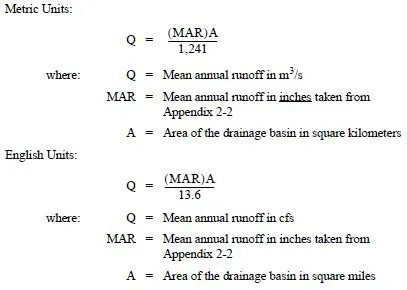This chapter presents WSDOT’s procedures and acceptable methodologies for hydraulics and hydrologic analyses for transportation hydraulic features. The procedures and methodologies presented in this chapter are based on a basic understanding of the science of hydrology and its principles. Additionally, the PEO should be familiar with the regulations and requirements of various state and federal agencies that regulate water-related construction, as they may be applicable to proposed improvements.
WSDOT uses several methods for determining runoff rates and/or volumes. However, documented reporting and high-water mark observations shall be used wherever possible to calibrate or validate the results of the below statistical and empirical methods. Where calculated results vary from on-site observations, further investigation may be required. The following methods are discussed in detail in subsequent sections of this chapter:
1. Rational Method
2. Santa Barbara Urban Hydrograph (SBUH) Method
3. Continuous-Simulation Hydrologic Model (MGSFlood)
4. Published flow record
5. United States Geological Survey (USGS) regional regression equations
6. Existing hydrologic studies
7. Documented reporting
Documented testimony of long-time residents should be given serious consideration by the PEO. Independent calculations should be made to verify this type of reporting and observations. The information furnished by residents of the area should include, but not be limited to, the following:
e. Dates of past floods
f. High-water marks
g. Amount of drift
h. Any changes in the channel that may be occurring (i.e., streambed stability—is the channel widening, migrating, or meandering)
i. Estimated velocity
j. Description of flooding characteristics between normal flow to flood stage
8. High-water mark observations
High-water marks can be used to reconstruct discharge from past flood events on existing structures or on the bank of a stream or ditch. However, caution should be applied if the high-water marks are from a similar period (e.g., bathymetry/topography similar, flood event did not inundate nearby culverts or bridges causing backwater, was not significant debris, etc.). These marks, along with other data, can be used to determine discharge by methods discussed in Chapter 3 or Chapter 4.
Additional hydrologic procedures are available including complex computer models, which can give the PEO accurate flood flow predictions. The State Hydraulics Office shall be contacted before a procedure other than those listed above is used in a hydrologic analysis.
The State Hydraulics Office and RHE require one of the first six methods listed above. Exceptions will be permitted if adequate justification is provided and approved by the RHE.
Section 2-2 discusses how to select the appropriate method of assessing hydrology for a given site. Sections 2-3 and 2-5 discuss other important considerations, including the size of the basin and things to consider in cold climate areas. The remainder of the chapter describes each of the methods in more detail, followed by some examples in Section 2-12.
